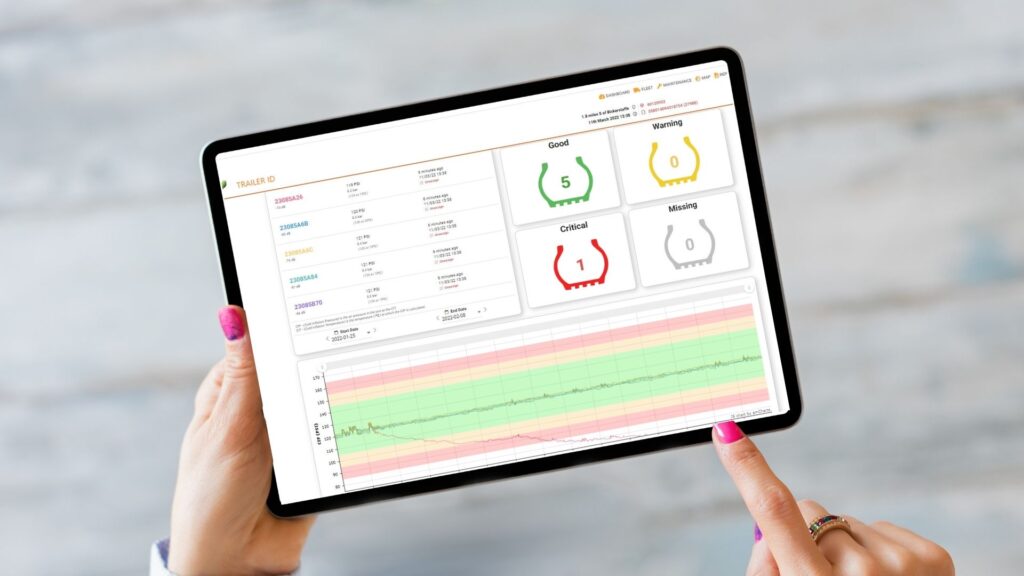
Introduction
HGV fleets play a vital role in delivering goods and services across the globe. Ensuring the safety and efficiency of these vehicles is paramount, and one technology that has revolutionized the monitoring of vehicle performance is the Tyre Pressure Monitoring System (TPMS). In this article, we explore the benefits of TPMS for HGV fleets and its significant impact on safety, cost savings, and overall operational efficiency.
Safety First
Tyre-related incidents pose significant risks on the road, particularly for HGVs due to their substantial size and weight. Proper tyre maintenance is crucial to prevent blowouts, reduced traction, and instability. TPMS continuously monitors tyre pressure and temperature, providing real-time alerts to the driver or fleet manager if any anomalies are detected. This helps in identifying potential tyre failures and allows for prompt action, preventing accidents and enhancing overall road safety.
Fuel Efficiency and Cost Savings
Maintaining the optimal tyre pressure is key to maximizing fuel efficiency. Underinflated tyres increase rolling resistance, resulting in decreased fuel economy. TPMS helps maintain the recommended tyre pressure, ensuring the fleet operates at peak efficiency. By reducing fuel consumption, HGV fleets can achieve substantial cost savings over time.
Extended Tyre Lifespan
Overinflated or underinflated tyres can lead to premature wear and tear, reducing their overall lifespan. TPMS ensures that tyres are properly inflated, minimizing the risk of irregular wear patterns and prolonging tyre longevity. By extending tyre life, HGV fleet operators can significantly reduce their spend on associated tyre replacement.
Time and Maintenance Efficiency
Traditional tyre pressure checks are time-consuming and often neglected due to the demanding nature of the transportation industry. TPMS automates the monitoring process, eliminating the need for manual checks. Real-time alerts and data provided by TPMS enable fleet managers to proactively schedule maintenance, reducing downtime and ensuring that vehicles are always roadworthy.
Compliance with Regulations
Many countries have implemented regulations mandating the use of TPMS in commercial vehicles. In the UK, the DVSA Guide to Maintaining Roadworthiness, section 5.2 clearly states that a robust tyre management system is essential for any professional vehicle operator.
By adopting TPMS, fleet operators ensure compliance with these regulations, avoiding penalties and potential legal issues.
Implementation and Integration
To leverage the benefits of TPMS effectively, HGV fleet operators should consider the following steps:
· Selecting a TPMS solution tailored specifically for HGV fleets is essential. Factors such as durability, accuracy, real-time monitoring capabilities, and integration with fleet management systems should
be carefully evaluated.
· Professional installation of TPMS sensors on each tyre is necessary to ensure accurate monitoring. Training drivers and fleet managers on how to interpret TPMS alerts and take appropriate actions is critical for optimal utilization.
· TPMS generates a wealth of data that can be analyzed to identify patterns, trends, and areas for improvement. Fleet managers should utilize this data to optimize tyre maintenance, identify potential issues, and make informed decisions.
Conclusion
The integration of TPMS into HGV fleets is a significant step toward improving safety, reducing costs, and enhancing overall operational efficiency. By providing real-time monitoring, TPMS helps prevent tyre-related incidents, maximize fuel efficiency, extend tyre lifespan, streamline maintenance, and ensure compliance with regulations. As the transportation industry continues to evolve, TPMS technology will play an increasingly crucial role in driving safety and efficiency for HGV fleets. Embracing this technology will not only benefit fleet operators but also contribute to safer roads.